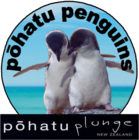What we do
Tracking at sea
Where do penguins go at sea?
Kororā spend 80% of their lives at sea so understanding their use of the marine habitat is primordial in their protection plan. Their populations are directly affected by ocean productivity and thus are measures of environmental health (Boersma 2008). Our responsibility as kaitiaki of this taonga is not only to protect them on land but at sea as well. By identifying marine areas that are critical to population survival and assessing the vulnerability of kororā to anthropogenic threats at sea, we can inform marine spatial planning and develop a comprehensive species management plan.
Flea Bay/Pōhatu and Motunau Island are the two largest colonies of white-flippered penguins. Tracking individuals at both sites allows us to determine the likelihood of intraspecific competition, colony immigration, and spatial overlap in foraging ranges. We can also quantify and compare the spatial overlap between penguins and anthropogenic activities (e.g., fisheries and tourism) and then identify potential risks associated with climate change and environmental variability. We will track up to 30 kororā per year per site for at least two years, primarily during the three main stages of the breeding season (incubation, chick guard, postguard). As long-term tracking continues, we expect to track during the premoult and winter seasons as well. We use small GPS dive loggers combined with a time-depth recorder.
During deployment and retrieval, we temporarily remove an adult penguin from the nest or catch it by hand as it returns to or leaves the colony, making sure disturbance to other nests and penguins is minimized. We record weight and bill dimensions followed by PIT tag marking (unless the penguin is already marked). Then, we attach GPS loggers using adhesive tape to the lower back of breeding penguins in good body condition Devices are only be attached to birds in good body condition who weigh greater than 800g. The entire process will not exceed 15 minutes per individual. The penguin is released at the entrance to the nest box or burrow to minimize disruption to eggs, chicks, or other penguins. Devices will be deployed for 2-7 days.
|
An introductory video about the importance that marine birds play in our marine environment, and the importance of research allowing us to understand their behaviours and marine habitat use to better protect them.
|
To celebrate the 10th anniversary of the Akaroa Marine Reserve and the 25th anniversary of the Pōhatu Marine Reserve, key stakeholders gathered on the 10th of March during Sea-week 2024 to commemorate these achievements for New Zealand marine wildlife. |
Hear from Dr Rachel Hickcox about the importance of monitoring a penguin colony. |
|
Discover the ins and outs of our Adopt a penguin program
|

